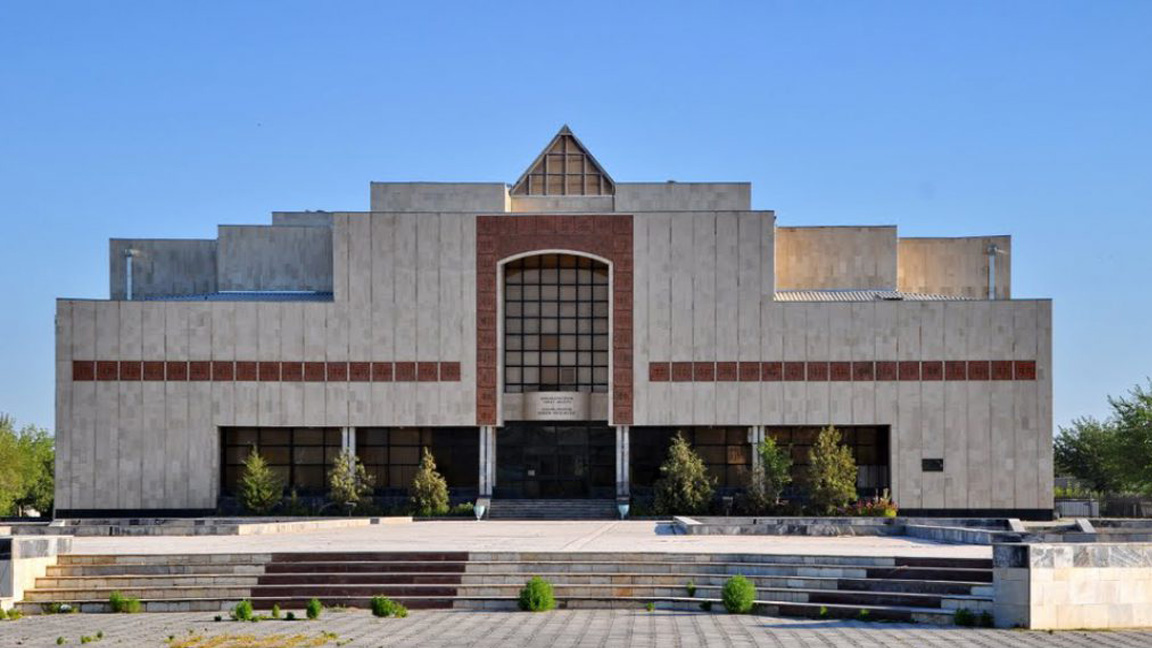


The capital of Karakalpakstan, Nukus (No’kis) is almost in the geographic center of the republic. It was founded on April 1, 1932. It is located on the Amudarja between the Kyzylkum in the east and the Karakum in the west and has almost 230,000 inhabitants. The city is laid out in a typical Soviet style with wide prospects, residential silos and large squares. For those interested in architecture, the Nukus is an excellent place to study Soviet urban planning. The city looks like a Soviet oasis in the middle of the desert. Nevertheless, one can feel the privatization here too. There are several places of interest in Nukus that are worth the trip, most notably the Savitskiy Museum with its collection of Russian avant-garde artists. But the Nukus market is also something special in its size and variety of goods. The museum of local history, which is worth seeing, was unfortunately torn down in 2011. The exhibits are currently in the Pushkin School near the Savitskiy Museum. The employees of the museum are committed to having their own building made available again. So far, however, it is unclear whether and when this will happen. The painter Igor Savitskiy (1915–1984), an artist from Moscow, came to Khorezmia in the mid-20th century as a member of the Archaeological Khorezmia Expedition of the Soviet Academy of Sciences. At first he worked as an expedition draftsman and thus discovered his love for the region. This is particularly evident in his Khiva pictures from the 1950s. He moved to Nukus, was enthusiastic about ethnographic applied arts and young Russian and local painters, whose works he bought. He also managed to acquire numerous works by artists persecuted under Stalin and, so to speak, to bring them to safety here in the desert.
Savitskiy Museum
The Karakalpakstan Art Museum is known beyond the borders of Uzbekistan for its exclusive collection of Russian avant-garde artists. Igor Savitskiy used the freedom as director of a museum in Nukus, a remote city from Moscow, to collect important works by Soviet artists who were not satisfied with socialist realism. The new building of the museum in the city center was officially opened in 2003.
Mizdach Chan and Gjaur kala
In the vicinity of the city there is a burial city (Mizdach Chan from the 9th to 11th centuries) and the fortress (Gjaur Kala) from the 4th to 2nd centuries BC. Not far from the former capital of Khorezmia Konya-Urgench (today Turkmenistan), this complex may have served as a suburb for Konya-Urgench. The fortress can only be guessed at, the burial city is a conglomerate of medieval and modern graves. Before the Arabs spread Islam in this region, Buddhism, Zoroastrianism and Christian Nestorianism dominated. In its origin it is therefore not a purely Islamic cemetery. On many graves there are mostly seven-step ladders, a shamanic Mongolian tradition that symbolizes the entrance from one world to the other. Here you can also see the stacked stones, also mostly seven, which express certain wishes. Archeology is alive, medieval ceramics and even glass can be found at every turn. Noteworthy is the Nazlymxan sulyu (also Mazlymxan sulu) mausoleum, restored in the 1980s, which is semi-underground and has simple but varied decorations. Originally the mausoleum was built as a caravanserai. However, as a result of the destruction caused by the Mongol invasion, the caravan trade came to a complete standstill, so that caravanserais were no longer needed. From then on, the building was used as a mausoleum. At the Halfa-Jerezheb Medrese, originally built in the 9th century, you can see that there is a reed cover in the foundation that protects the building from moisture and stabilizes it in the event of earthquakes. Crosses are depicted on two graves immediately next to it.